Business Environment Report: Tesco PLC and Organizational Structure
VerifiedAdded on 2020/07/22
|18
|5250
|25
Report
AI Summary
This report provides a comprehensive analysis of Tesco PLC's business environment. It begins by exploring different types of organizations, their purposes, and legal structures, with a specific focus on private, public, and voluntary sectors. The report then examines the size and scope of various business associations, relating them to Tesco's business objectives and services. The analysis includes an examination of the relationships between organizational functions, such as sales and marketing, research and development, and human resource management, and their impact on achieving business goals. It also highlights the advantages and disadvantages of interrelationships between organizational functions. Furthermore, the report delves into the complexities of different business structures, using PESTEL and SWOT analyses to evaluate the macro and micro environments and their influence on Tesco's decision-making processes and objectives. Overall, the report offers a detailed understanding of the factors influencing Tesco's operations and strategic planning within its business environment.

Business Environment
Paraphrase This Document
Need a fresh take? Get an instant paraphrase of this document with our AI Paraphraser

Table of Contents
INTRODUCTION...........................................................................................................................3
TASK...............................................................................................................................................3
1.1 Types of organisations and their purpose with legal structures............................................3
1.2 Size and scope of various association...................................................................................5
1.3 Relations of structure, size and scope of organisation to its business objectives and
services........................................................................................................................................7
Task 2...............................................................................................................................................7
2.1 Relationship between various organisation functions and its link with objectives..............7
2.2 Advantages and disadvantage of interrelationship between organisational functions..........9
2.3 Critical analysis complexities of various business structure.................................................9
CONCLUSION................................................................................................................................9
Project 2.........................................................................................................................................10
INTRODUCTION.........................................................................................................................10
TASK 1..........................................................................................................................................10
1.1 Positive and negative impact the macro environment has upon business operation...........10
1.2 Use of PESTEL modal to support a detailed analysis of the macro environment..............12
TASK 2..........................................................................................................................................13
2.1 Internal and external analysis to identify its strength and weaknesses...............................13
2.2 Interrelate strength and weakness with the external macro factors.....................................14
2.3 Influence SWOT analysis on decision making...................................................................15
........................................................................................................................................................15
2.4 Critical evaluation of influence of macro and micro environment on business objectives.16
CONCLUSION..............................................................................................................................16
REFERENCES..............................................................................................................................17
Online.............................................................................................................................................18
INTRODUCTION...........................................................................................................................3
TASK...............................................................................................................................................3
1.1 Types of organisations and their purpose with legal structures............................................3
1.2 Size and scope of various association...................................................................................5
1.3 Relations of structure, size and scope of organisation to its business objectives and
services........................................................................................................................................7
Task 2...............................................................................................................................................7
2.1 Relationship between various organisation functions and its link with objectives..............7
2.2 Advantages and disadvantage of interrelationship between organisational functions..........9
2.3 Critical analysis complexities of various business structure.................................................9
CONCLUSION................................................................................................................................9
Project 2.........................................................................................................................................10
INTRODUCTION.........................................................................................................................10
TASK 1..........................................................................................................................................10
1.1 Positive and negative impact the macro environment has upon business operation...........10
1.2 Use of PESTEL modal to support a detailed analysis of the macro environment..............12
TASK 2..........................................................................................................................................13
2.1 Internal and external analysis to identify its strength and weaknesses...............................13
2.2 Interrelate strength and weakness with the external macro factors.....................................14
2.3 Influence SWOT analysis on decision making...................................................................15
........................................................................................................................................................15
2.4 Critical evaluation of influence of macro and micro environment on business objectives.16
CONCLUSION..............................................................................................................................16
REFERENCES..............................................................................................................................17
Online.............................................................................................................................................18

INTRODUCTION
A firm is organised by group of people for the purpose of business or public serving and
earning profit. Managers have responsibilities to take actions such as planning, coordination,
structure, running, organising, arguments and logistics. Business is term of surrounding that
signifies all factors such as micro and macro which influence functioning of overall corporate
world. Tesco PLC is a British multinational grocery and general merchandise retailer with
having its headquartering in Welwyn Garden city, England, UK. In this project report, it will
explain different types and purposes of organisation along with size of public, private etc. It will
also describe about how organisational structure linked with business objectives and its
relationship with several functions. There are various complexities of different types of structure
that also explain in this.
TASK
1.1 Types of organisations and their purpose with legal structures
There are various types of firms in the market that deals with several kinds of products
and services. It consist number of organisation with different purposes like private, public and
voluntary enterprises. Some of companies are profitable and non-profitable as well as they has
similar objectives that earn money and wealth maximisation. They want maximum return from
their investment and satisfy customer's needs or wants. There are some types of business entity
such as:
A firm is organised by group of people for the purpose of business or public serving and
earning profit. Managers have responsibilities to take actions such as planning, coordination,
structure, running, organising, arguments and logistics. Business is term of surrounding that
signifies all factors such as micro and macro which influence functioning of overall corporate
world. Tesco PLC is a British multinational grocery and general merchandise retailer with
having its headquartering in Welwyn Garden city, England, UK. In this project report, it will
explain different types and purposes of organisation along with size of public, private etc. It will
also describe about how organisational structure linked with business objectives and its
relationship with several functions. There are various complexities of different types of structure
that also explain in this.
TASK
1.1 Types of organisations and their purpose with legal structures
There are various types of firms in the market that deals with several kinds of products
and services. It consist number of organisation with different purposes like private, public and
voluntary enterprises. Some of companies are profitable and non-profitable as well as they has
similar objectives that earn money and wealth maximisation. They want maximum return from
their investment and satisfy customer's needs or wants. There are some types of business entity
such as:
⊘ This is a preview!⊘
Do you want full access?
Subscribe today to unlock all pages.

Trusted by 1+ million students worldwide
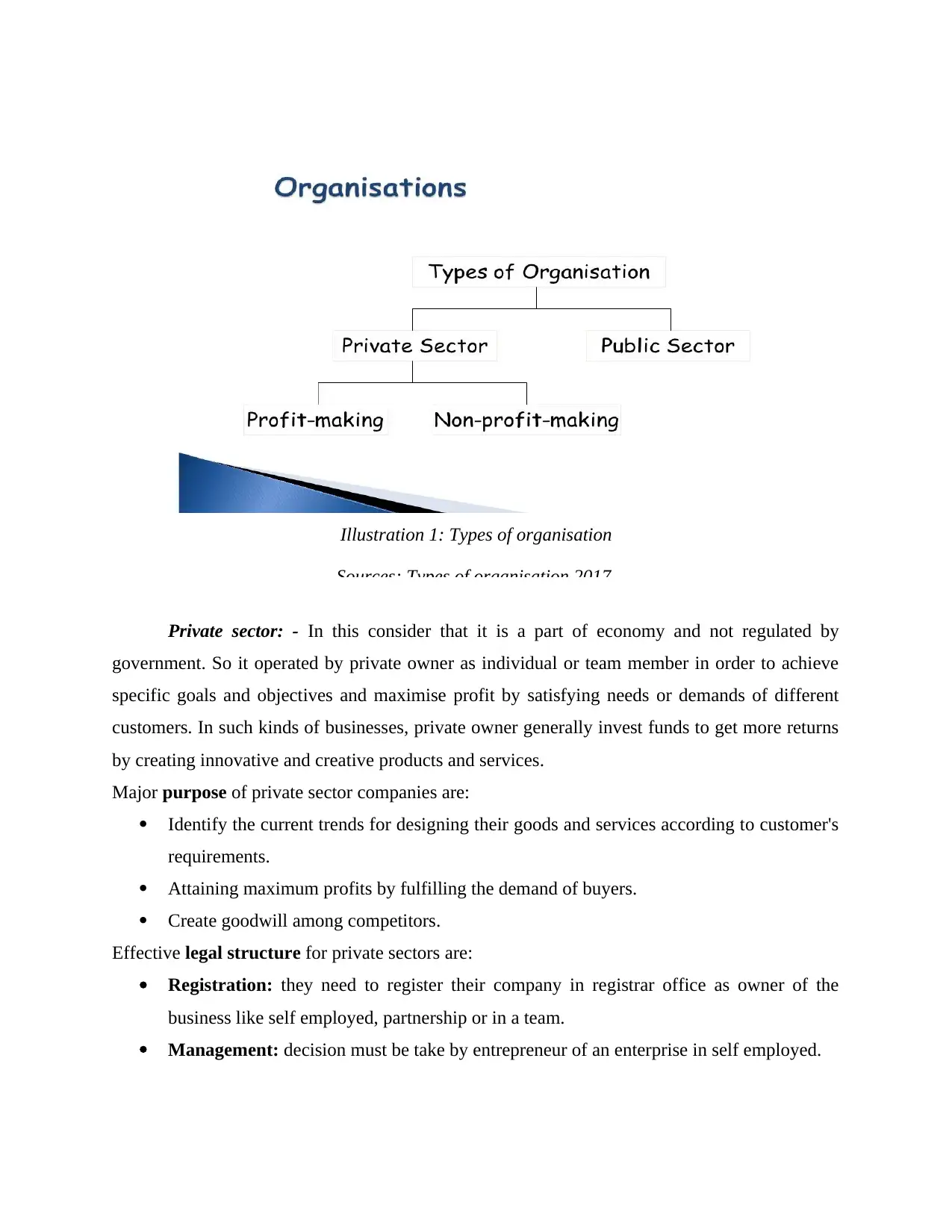
Private sector: - In this consider that it is a part of economy and not regulated by
government. So it operated by private owner as individual or team member in order to achieve
specific goals and objectives and maximise profit by satisfying needs or demands of different
customers. In such kinds of businesses, private owner generally invest funds to get more returns
by creating innovative and creative products and services.
Major purpose of private sector companies are:
Identify the current trends for designing their goods and services according to customer's
requirements.
Attaining maximum profits by fulfilling the demand of buyers.
Create goodwill among competitors.
Effective legal structure for private sectors are:
Registration: they need to register their company in registrar office as owner of the
business like self employed, partnership or in a team.
Management: decision must be take by entrepreneur of an enterprise in self employed.
Illustration 1: Types of organisation
Sources: Types of organisation 2017.
government. So it operated by private owner as individual or team member in order to achieve
specific goals and objectives and maximise profit by satisfying needs or demands of different
customers. In such kinds of businesses, private owner generally invest funds to get more returns
by creating innovative and creative products and services.
Major purpose of private sector companies are:
Identify the current trends for designing their goods and services according to customer's
requirements.
Attaining maximum profits by fulfilling the demand of buyers.
Create goodwill among competitors.
Effective legal structure for private sectors are:
Registration: they need to register their company in registrar office as owner of the
business like self employed, partnership or in a team.
Management: decision must be take by entrepreneur of an enterprise in self employed.
Illustration 1: Types of organisation
Sources: Types of organisation 2017.
Paraphrase This Document
Need a fresh take? Get an instant paraphrase of this document with our AI Paraphraser
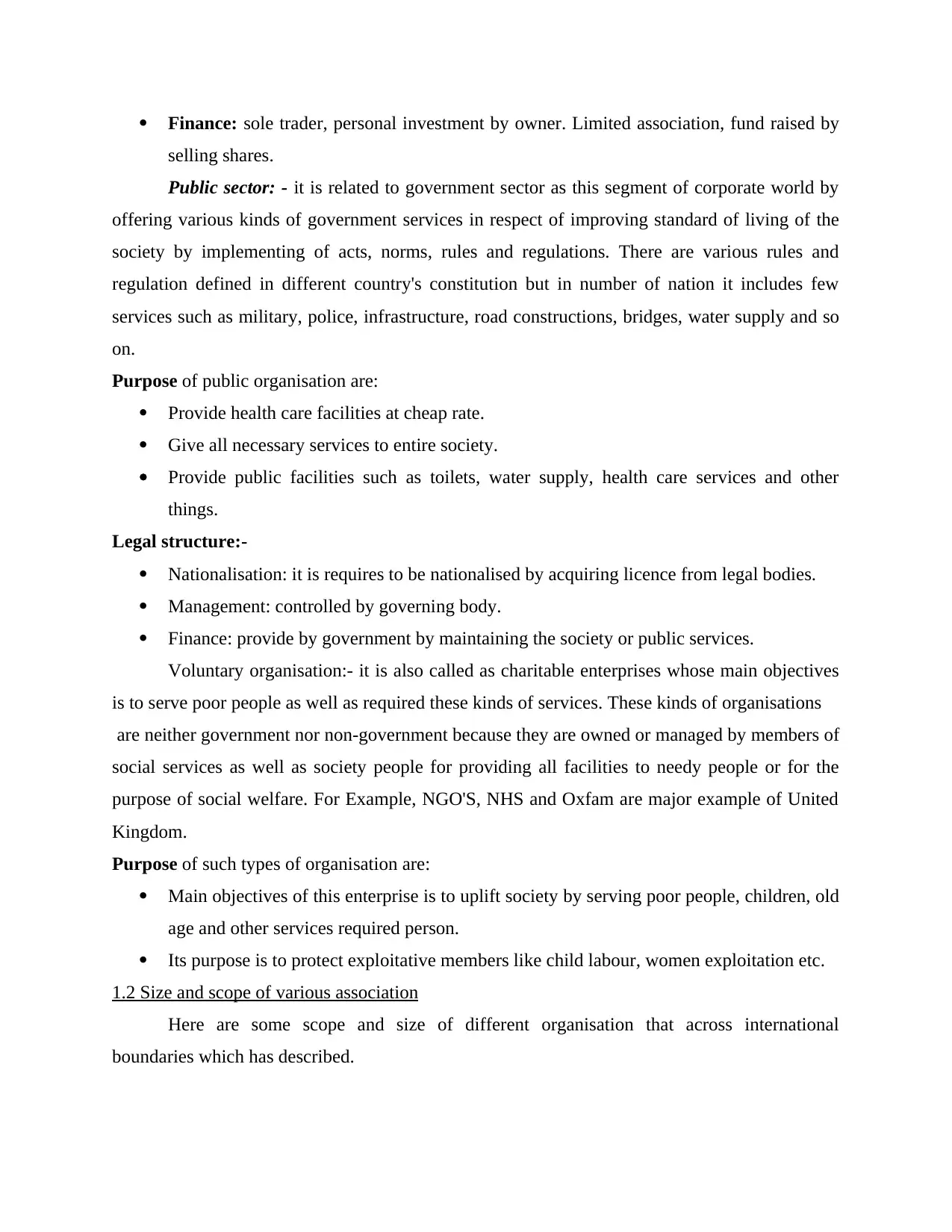
Finance: sole trader, personal investment by owner. Limited association, fund raised by
selling shares.
Public sector: - it is related to government sector as this segment of corporate world by
offering various kinds of government services in respect of improving standard of living of the
society by implementing of acts, norms, rules and regulations. There are various rules and
regulation defined in different country's constitution but in number of nation it includes few
services such as military, police, infrastructure, road constructions, bridges, water supply and so
on.
Purpose of public organisation are:
Provide health care facilities at cheap rate.
Give all necessary services to entire society.
Provide public facilities such as toilets, water supply, health care services and other
things.
Legal structure:-
Nationalisation: it is requires to be nationalised by acquiring licence from legal bodies.
Management: controlled by governing body.
Finance: provide by government by maintaining the society or public services.
Voluntary organisation:- it is also called as charitable enterprises whose main objectives
is to serve poor people as well as required these kinds of services. These kinds of organisations
are neither government nor non-government because they are owned or managed by members of
social services as well as society people for providing all facilities to needy people or for the
purpose of social welfare. For Example, NGO'S, NHS and Oxfam are major example of United
Kingdom.
Purpose of such types of organisation are:
Main objectives of this enterprise is to uplift society by serving poor people, children, old
age and other services required person.
Its purpose is to protect exploitative members like child labour, women exploitation etc.
1.2 Size and scope of various association
Here are some scope and size of different organisation that across international
boundaries which has described.
selling shares.
Public sector: - it is related to government sector as this segment of corporate world by
offering various kinds of government services in respect of improving standard of living of the
society by implementing of acts, norms, rules and regulations. There are various rules and
regulation defined in different country's constitution but in number of nation it includes few
services such as military, police, infrastructure, road constructions, bridges, water supply and so
on.
Purpose of public organisation are:
Provide health care facilities at cheap rate.
Give all necessary services to entire society.
Provide public facilities such as toilets, water supply, health care services and other
things.
Legal structure:-
Nationalisation: it is requires to be nationalised by acquiring licence from legal bodies.
Management: controlled by governing body.
Finance: provide by government by maintaining the society or public services.
Voluntary organisation:- it is also called as charitable enterprises whose main objectives
is to serve poor people as well as required these kinds of services. These kinds of organisations
are neither government nor non-government because they are owned or managed by members of
social services as well as society people for providing all facilities to needy people or for the
purpose of social welfare. For Example, NGO'S, NHS and Oxfam are major example of United
Kingdom.
Purpose of such types of organisation are:
Main objectives of this enterprise is to uplift society by serving poor people, children, old
age and other services required person.
Its purpose is to protect exploitative members like child labour, women exploitation etc.
1.2 Size and scope of various association
Here are some scope and size of different organisation that across international
boundaries which has described.
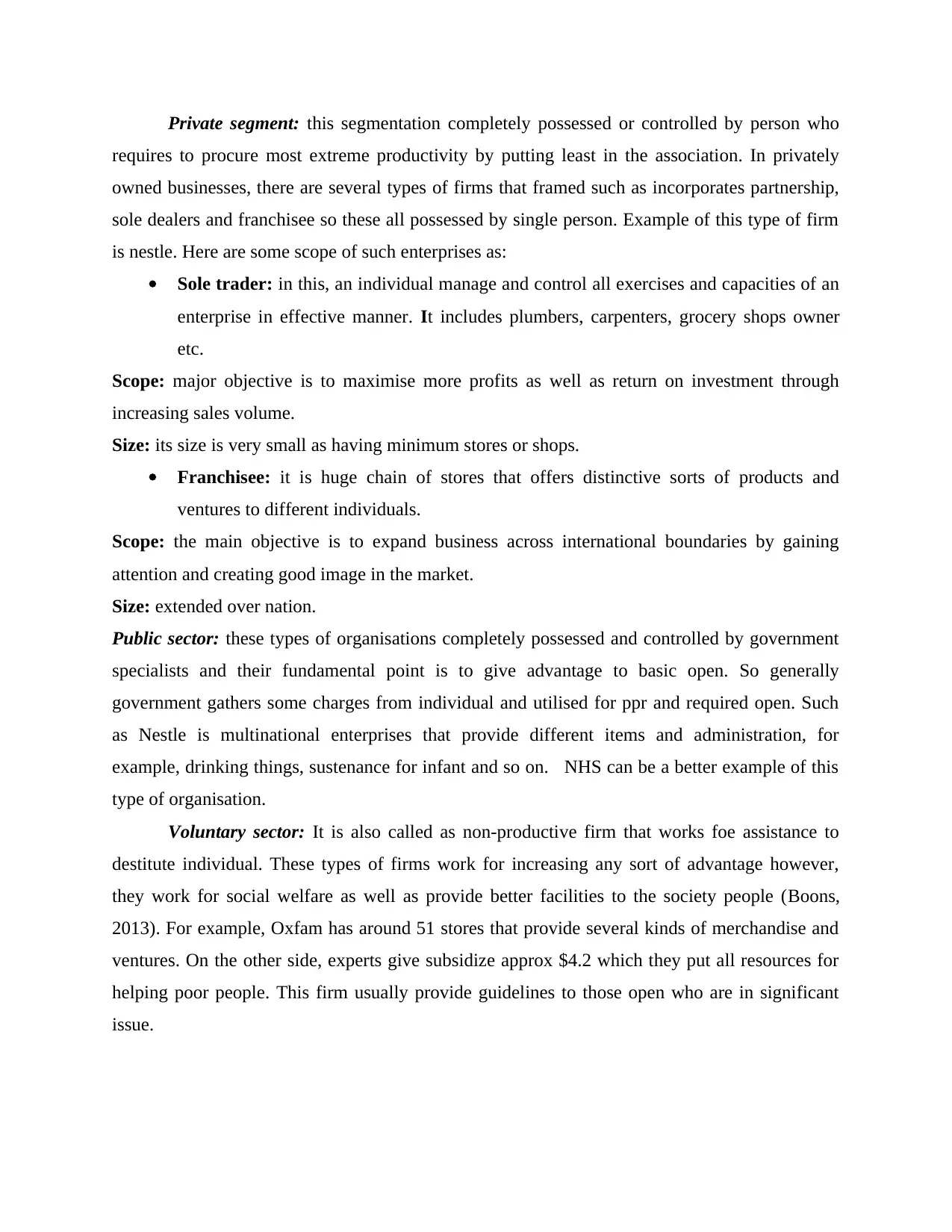
Private segment: this segmentation completely possessed or controlled by person who
requires to procure most extreme productivity by putting least in the association. In privately
owned businesses, there are several types of firms that framed such as incorporates partnership,
sole dealers and franchisee so these all possessed by single person. Example of this type of firm
is nestle. Here are some scope of such enterprises as:
Sole trader: in this, an individual manage and control all exercises and capacities of an
enterprise in effective manner. It includes plumbers, carpenters, grocery shops owner
etc.
Scope: major objective is to maximise more profits as well as return on investment through
increasing sales volume.
Size: its size is very small as having minimum stores or shops.
Franchisee: it is huge chain of stores that offers distinctive sorts of products and
ventures to different individuals.
Scope: the main objective is to expand business across international boundaries by gaining
attention and creating good image in the market.
Size: extended over nation.
Public sector: these types of organisations completely possessed and controlled by government
specialists and their fundamental point is to give advantage to basic open. So generally
government gathers some charges from individual and utilised for ppr and required open. Such
as Nestle is multinational enterprises that provide different items and administration, for
example, drinking things, sustenance for infant and so on. NHS can be a better example of this
type of organisation.
Voluntary sector: It is also called as non-productive firm that works foe assistance to
destitute individual. These types of firms work for increasing any sort of advantage however,
they work for social welfare as well as provide better facilities to the society people (Boons,
2013). For example, Oxfam has around 51 stores that provide several kinds of merchandise and
ventures. On the other side, experts give subsidize approx $4.2 which they put all resources for
helping poor people. This firm usually provide guidelines to those open who are in significant
issue.
requires to procure most extreme productivity by putting least in the association. In privately
owned businesses, there are several types of firms that framed such as incorporates partnership,
sole dealers and franchisee so these all possessed by single person. Example of this type of firm
is nestle. Here are some scope of such enterprises as:
Sole trader: in this, an individual manage and control all exercises and capacities of an
enterprise in effective manner. It includes plumbers, carpenters, grocery shops owner
etc.
Scope: major objective is to maximise more profits as well as return on investment through
increasing sales volume.
Size: its size is very small as having minimum stores or shops.
Franchisee: it is huge chain of stores that offers distinctive sorts of products and
ventures to different individuals.
Scope: the main objective is to expand business across international boundaries by gaining
attention and creating good image in the market.
Size: extended over nation.
Public sector: these types of organisations completely possessed and controlled by government
specialists and their fundamental point is to give advantage to basic open. So generally
government gathers some charges from individual and utilised for ppr and required open. Such
as Nestle is multinational enterprises that provide different items and administration, for
example, drinking things, sustenance for infant and so on. NHS can be a better example of this
type of organisation.
Voluntary sector: It is also called as non-productive firm that works foe assistance to
destitute individual. These types of firms work for increasing any sort of advantage however,
they work for social welfare as well as provide better facilities to the society people (Boons,
2013). For example, Oxfam has around 51 stores that provide several kinds of merchandise and
ventures. On the other side, experts give subsidize approx $4.2 which they put all resources for
helping poor people. This firm usually provide guidelines to those open who are in significant
issue.
⊘ This is a preview!⊘
Do you want full access?
Subscribe today to unlock all pages.

Trusted by 1+ million students worldwide
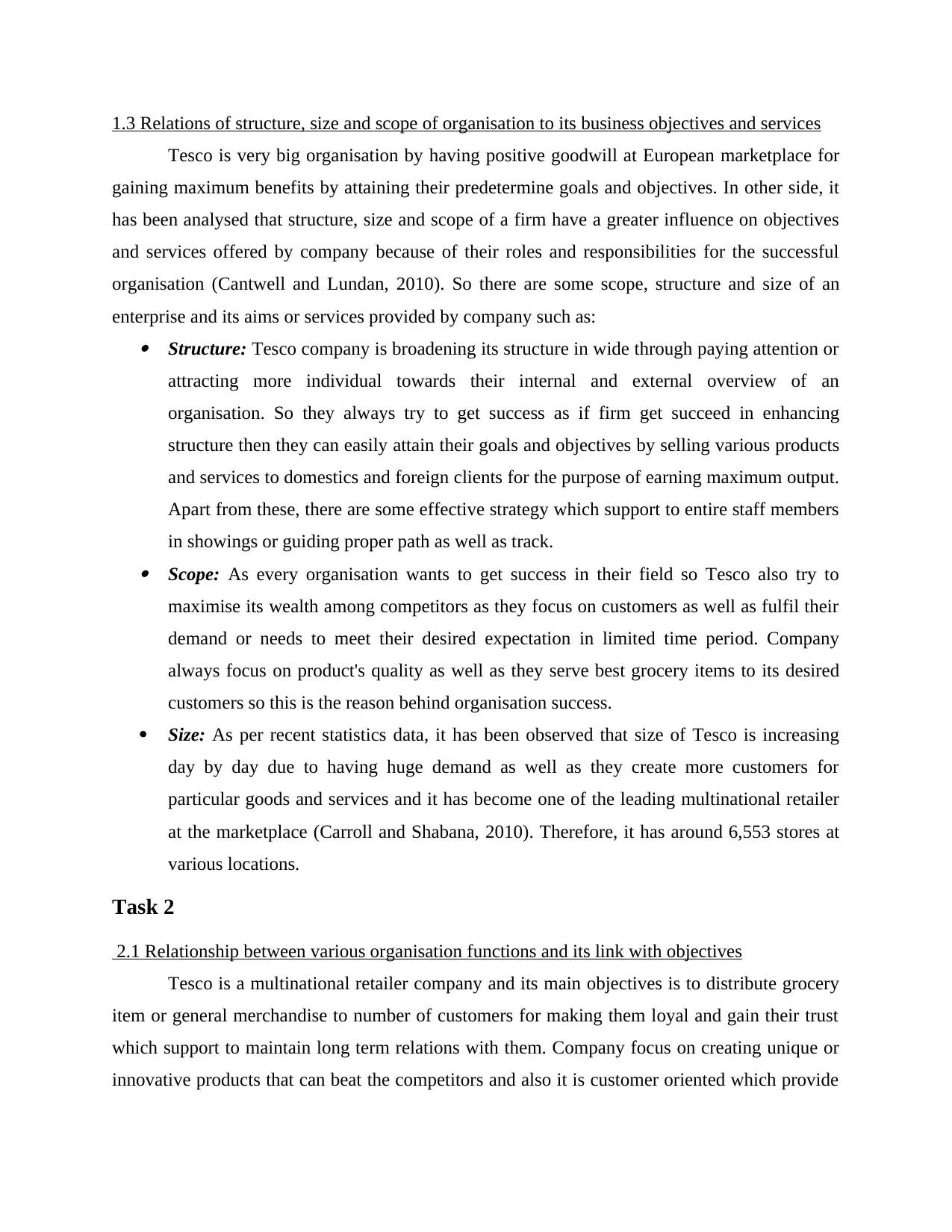
1.3 Relations of structure, size and scope of organisation to its business objectives and services
Tesco is very big organisation by having positive goodwill at European marketplace for
gaining maximum benefits by attaining their predetermine goals and objectives. In other side, it
has been analysed that structure, size and scope of a firm have a greater influence on objectives
and services offered by company because of their roles and responsibilities for the successful
organisation (Cantwell and Lundan, 2010). So there are some scope, structure and size of an
enterprise and its aims or services provided by company such as: Structure: Tesco company is broadening its structure in wide through paying attention or
attracting more individual towards their internal and external overview of an
organisation. So they always try to get success as if firm get succeed in enhancing
structure then they can easily attain their goals and objectives by selling various products
and services to domestics and foreign clients for the purpose of earning maximum output.
Apart from these, there are some effective strategy which support to entire staff members
in showings or guiding proper path as well as track. Scope: As every organisation wants to get success in their field so Tesco also try to
maximise its wealth among competitors as they focus on customers as well as fulfil their
demand or needs to meet their desired expectation in limited time period. Company
always focus on product's quality as well as they serve best grocery items to its desired
customers so this is the reason behind organisation success.
Size: As per recent statistics data, it has been observed that size of Tesco is increasing
day by day due to having huge demand as well as they create more customers for
particular goods and services and it has become one of the leading multinational retailer
at the marketplace (Carroll and Shabana, 2010). Therefore, it has around 6,553 stores at
various locations.
Task 2
2.1 Relationship between various organisation functions and its link with objectives
Tesco is a multinational retailer company and its main objectives is to distribute grocery
item or general merchandise to number of customers for making them loyal and gain their trust
which support to maintain long term relations with them. Company focus on creating unique or
innovative products that can beat the competitors and also it is customer oriented which provide
Tesco is very big organisation by having positive goodwill at European marketplace for
gaining maximum benefits by attaining their predetermine goals and objectives. In other side, it
has been analysed that structure, size and scope of a firm have a greater influence on objectives
and services offered by company because of their roles and responsibilities for the successful
organisation (Cantwell and Lundan, 2010). So there are some scope, structure and size of an
enterprise and its aims or services provided by company such as: Structure: Tesco company is broadening its structure in wide through paying attention or
attracting more individual towards their internal and external overview of an
organisation. So they always try to get success as if firm get succeed in enhancing
structure then they can easily attain their goals and objectives by selling various products
and services to domestics and foreign clients for the purpose of earning maximum output.
Apart from these, there are some effective strategy which support to entire staff members
in showings or guiding proper path as well as track. Scope: As every organisation wants to get success in their field so Tesco also try to
maximise its wealth among competitors as they focus on customers as well as fulfil their
demand or needs to meet their desired expectation in limited time period. Company
always focus on product's quality as well as they serve best grocery items to its desired
customers so this is the reason behind organisation success.
Size: As per recent statistics data, it has been observed that size of Tesco is increasing
day by day due to having huge demand as well as they create more customers for
particular goods and services and it has become one of the leading multinational retailer
at the marketplace (Carroll and Shabana, 2010). Therefore, it has around 6,553 stores at
various locations.
Task 2
2.1 Relationship between various organisation functions and its link with objectives
Tesco is a multinational retailer company and its main objectives is to distribute grocery
item or general merchandise to number of customers for making them loyal and gain their trust
which support to maintain long term relations with them. Company focus on creating unique or
innovative products that can beat the competitors and also it is customer oriented which provide
Paraphrase This Document
Need a fresh take? Get an instant paraphrase of this document with our AI Paraphraser
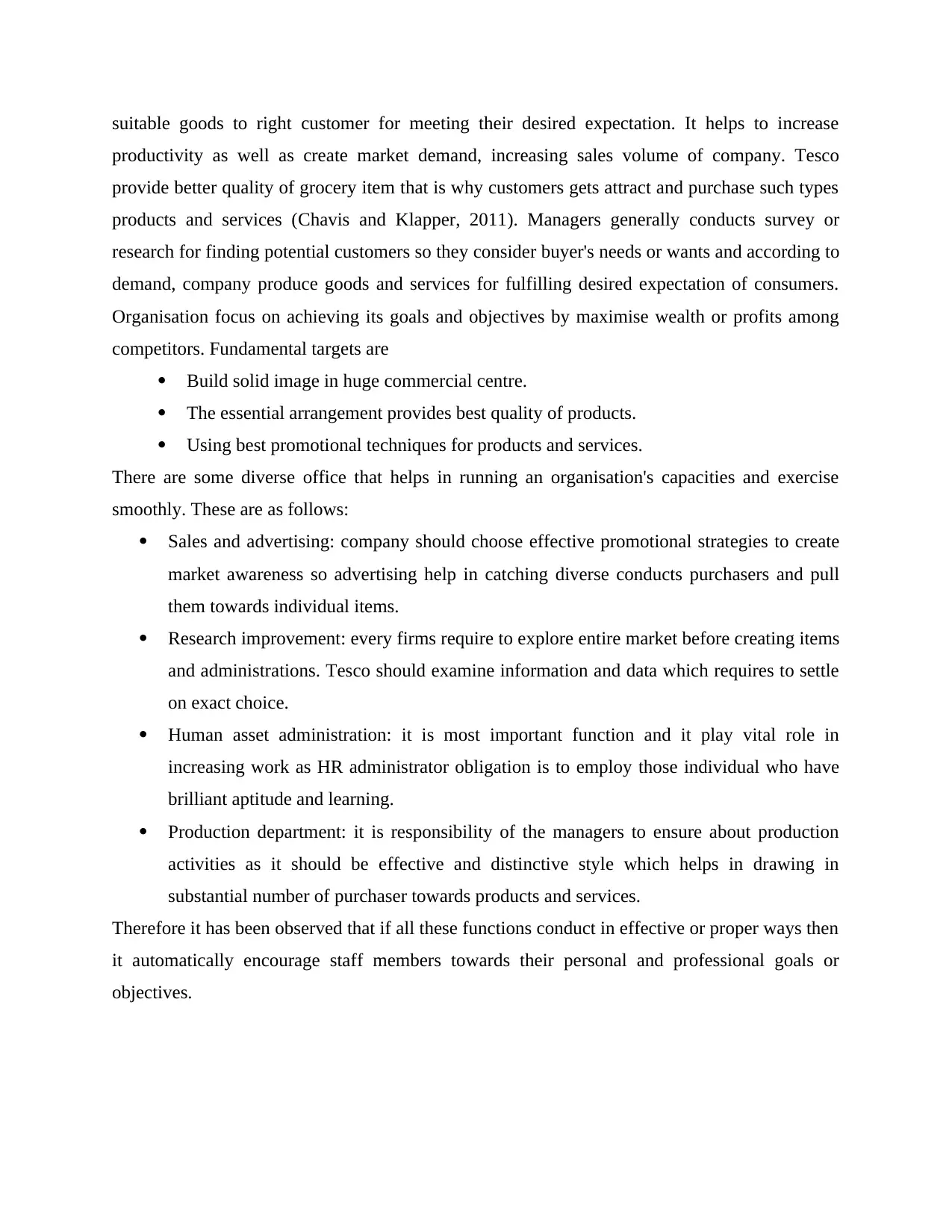
suitable goods to right customer for meeting their desired expectation. It helps to increase
productivity as well as create market demand, increasing sales volume of company. Tesco
provide better quality of grocery item that is why customers gets attract and purchase such types
products and services (Chavis and Klapper, 2011). Managers generally conducts survey or
research for finding potential customers so they consider buyer's needs or wants and according to
demand, company produce goods and services for fulfilling desired expectation of consumers.
Organisation focus on achieving its goals and objectives by maximise wealth or profits among
competitors. Fundamental targets are
Build solid image in huge commercial centre.
The essential arrangement provides best quality of products.
Using best promotional techniques for products and services.
There are some diverse office that helps in running an organisation's capacities and exercise
smoothly. These are as follows:
Sales and advertising: company should choose effective promotional strategies to create
market awareness so advertising help in catching diverse conducts purchasers and pull
them towards individual items.
Research improvement: every firms require to explore entire market before creating items
and administrations. Tesco should examine information and data which requires to settle
on exact choice.
Human asset administration: it is most important function and it play vital role in
increasing work as HR administrator obligation is to employ those individual who have
brilliant aptitude and learning.
Production department: it is responsibility of the managers to ensure about production
activities as it should be effective and distinctive style which helps in drawing in
substantial number of purchaser towards products and services.
Therefore it has been observed that if all these functions conduct in effective or proper ways then
it automatically encourage staff members towards their personal and professional goals or
objectives.
productivity as well as create market demand, increasing sales volume of company. Tesco
provide better quality of grocery item that is why customers gets attract and purchase such types
products and services (Chavis and Klapper, 2011). Managers generally conducts survey or
research for finding potential customers so they consider buyer's needs or wants and according to
demand, company produce goods and services for fulfilling desired expectation of consumers.
Organisation focus on achieving its goals and objectives by maximise wealth or profits among
competitors. Fundamental targets are
Build solid image in huge commercial centre.
The essential arrangement provides best quality of products.
Using best promotional techniques for products and services.
There are some diverse office that helps in running an organisation's capacities and exercise
smoothly. These are as follows:
Sales and advertising: company should choose effective promotional strategies to create
market awareness so advertising help in catching diverse conducts purchasers and pull
them towards individual items.
Research improvement: every firms require to explore entire market before creating items
and administrations. Tesco should examine information and data which requires to settle
on exact choice.
Human asset administration: it is most important function and it play vital role in
increasing work as HR administrator obligation is to employ those individual who have
brilliant aptitude and learning.
Production department: it is responsibility of the managers to ensure about production
activities as it should be effective and distinctive style which helps in drawing in
substantial number of purchaser towards products and services.
Therefore it has been observed that if all these functions conduct in effective or proper ways then
it automatically encourage staff members towards their personal and professional goals or
objectives.
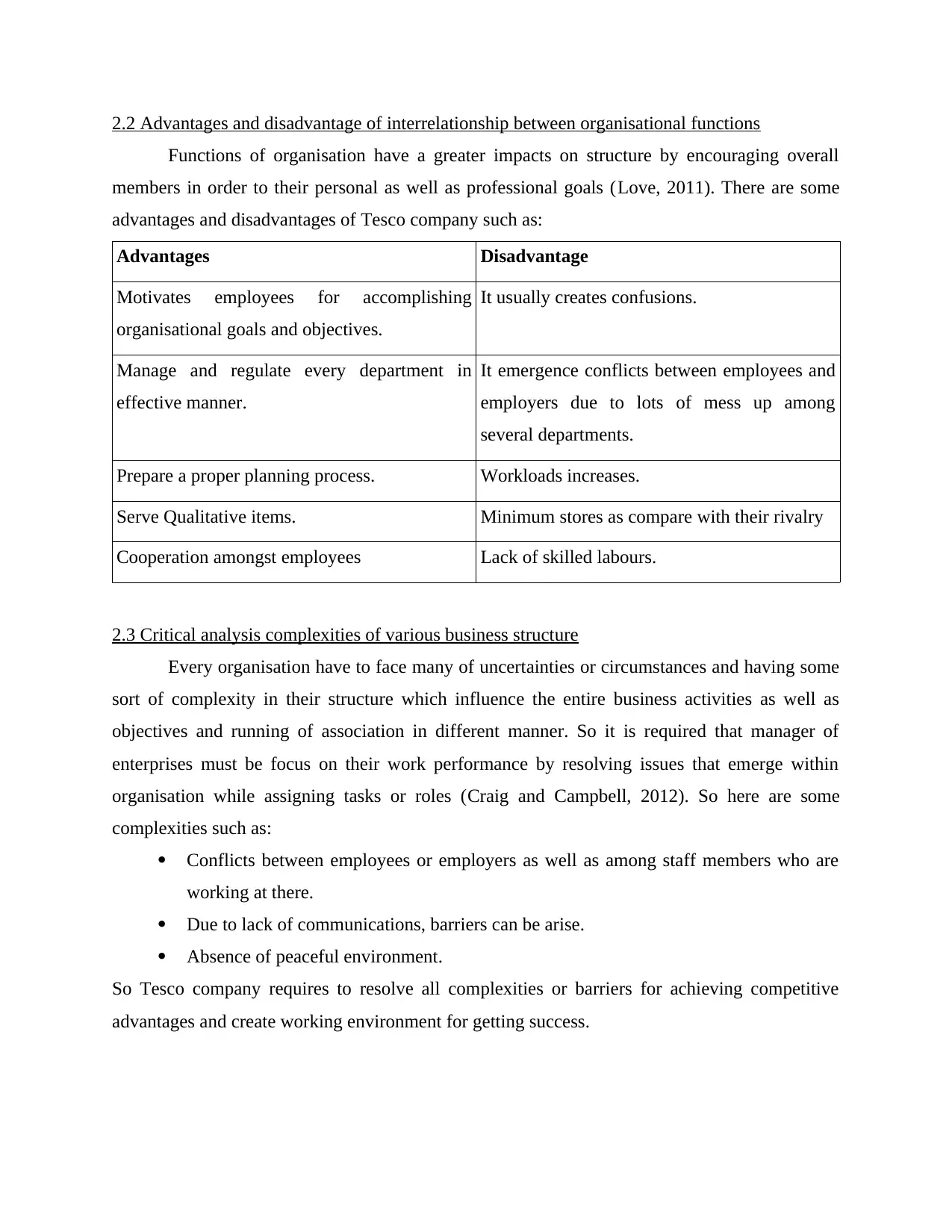
2.2 Advantages and disadvantage of interrelationship between organisational functions
Functions of organisation have a greater impacts on structure by encouraging overall
members in order to their personal as well as professional goals (Love, 2011). There are some
advantages and disadvantages of Tesco company such as:
Advantages Disadvantage
Motivates employees for accomplishing
organisational goals and objectives.
It usually creates confusions.
Manage and regulate every department in
effective manner.
It emergence conflicts between employees and
employers due to lots of mess up among
several departments.
Prepare a proper planning process. Workloads increases.
Serve Qualitative items. Minimum stores as compare with their rivalry
Cooperation amongst employees Lack of skilled labours.
2.3 Critical analysis complexities of various business structure
Every organisation have to face many of uncertainties or circumstances and having some
sort of complexity in their structure which influence the entire business activities as well as
objectives and running of association in different manner. So it is required that manager of
enterprises must be focus on their work performance by resolving issues that emerge within
organisation while assigning tasks or roles (Craig and Campbell, 2012). So here are some
complexities such as:
Conflicts between employees or employers as well as among staff members who are
working at there.
Due to lack of communications, barriers can be arise.
Absence of peaceful environment.
So Tesco company requires to resolve all complexities or barriers for achieving competitive
advantages and create working environment for getting success.
Functions of organisation have a greater impacts on structure by encouraging overall
members in order to their personal as well as professional goals (Love, 2011). There are some
advantages and disadvantages of Tesco company such as:
Advantages Disadvantage
Motivates employees for accomplishing
organisational goals and objectives.
It usually creates confusions.
Manage and regulate every department in
effective manner.
It emergence conflicts between employees and
employers due to lots of mess up among
several departments.
Prepare a proper planning process. Workloads increases.
Serve Qualitative items. Minimum stores as compare with their rivalry
Cooperation amongst employees Lack of skilled labours.
2.3 Critical analysis complexities of various business structure
Every organisation have to face many of uncertainties or circumstances and having some
sort of complexity in their structure which influence the entire business activities as well as
objectives and running of association in different manner. So it is required that manager of
enterprises must be focus on their work performance by resolving issues that emerge within
organisation while assigning tasks or roles (Craig and Campbell, 2012). So here are some
complexities such as:
Conflicts between employees or employers as well as among staff members who are
working at there.
Due to lack of communications, barriers can be arise.
Absence of peaceful environment.
So Tesco company requires to resolve all complexities or barriers for achieving competitive
advantages and create working environment for getting success.
⊘ This is a preview!⊘
Do you want full access?
Subscribe today to unlock all pages.

Trusted by 1+ million students worldwide
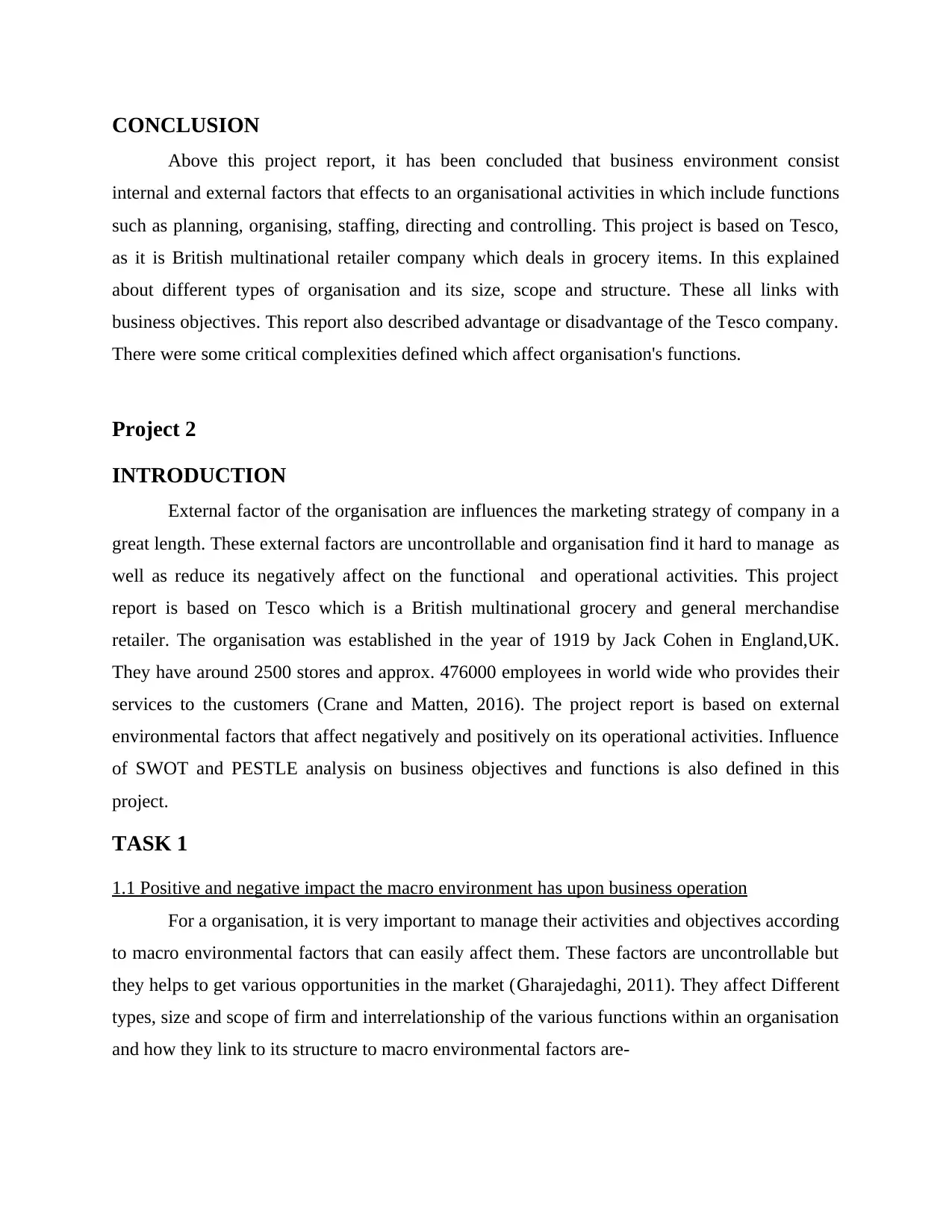
CONCLUSION
Above this project report, it has been concluded that business environment consist
internal and external factors that effects to an organisational activities in which include functions
such as planning, organising, staffing, directing and controlling. This project is based on Tesco,
as it is British multinational retailer company which deals in grocery items. In this explained
about different types of organisation and its size, scope and structure. These all links with
business objectives. This report also described advantage or disadvantage of the Tesco company.
There were some critical complexities defined which affect organisation's functions.
Project 2
INTRODUCTION
External factor of the organisation are influences the marketing strategy of company in a
great length. These external factors are uncontrollable and organisation find it hard to manage as
well as reduce its negatively affect on the functional and operational activities. This project
report is based on Tesco which is a British multinational grocery and general merchandise
retailer. The organisation was established in the year of 1919 by Jack Cohen in England,UK.
They have around 2500 stores and approx. 476000 employees in world wide who provides their
services to the customers (Crane and Matten, 2016). The project report is based on external
environmental factors that affect negatively and positively on its operational activities. Influence
of SWOT and PESTLE analysis on business objectives and functions is also defined in this
project.
TASK 1
1.1 Positive and negative impact the macro environment has upon business operation
For a organisation, it is very important to manage their activities and objectives according
to macro environmental factors that can easily affect them. These factors are uncontrollable but
they helps to get various opportunities in the market (Gharajedaghi, 2011). They affect Different
types, size and scope of firm and interrelationship of the various functions within an organisation
and how they link to its structure to macro environmental factors are-
Above this project report, it has been concluded that business environment consist
internal and external factors that effects to an organisational activities in which include functions
such as planning, organising, staffing, directing and controlling. This project is based on Tesco,
as it is British multinational retailer company which deals in grocery items. In this explained
about different types of organisation and its size, scope and structure. These all links with
business objectives. This report also described advantage or disadvantage of the Tesco company.
There were some critical complexities defined which affect organisation's functions.
Project 2
INTRODUCTION
External factor of the organisation are influences the marketing strategy of company in a
great length. These external factors are uncontrollable and organisation find it hard to manage as
well as reduce its negatively affect on the functional and operational activities. This project
report is based on Tesco which is a British multinational grocery and general merchandise
retailer. The organisation was established in the year of 1919 by Jack Cohen in England,UK.
They have around 2500 stores and approx. 476000 employees in world wide who provides their
services to the customers (Crane and Matten, 2016). The project report is based on external
environmental factors that affect negatively and positively on its operational activities. Influence
of SWOT and PESTLE analysis on business objectives and functions is also defined in this
project.
TASK 1
1.1 Positive and negative impact the macro environment has upon business operation
For a organisation, it is very important to manage their activities and objectives according
to macro environmental factors that can easily affect them. These factors are uncontrollable but
they helps to get various opportunities in the market (Gharajedaghi, 2011). They affect Different
types, size and scope of firm and interrelationship of the various functions within an organisation
and how they link to its structure to macro environmental factors are-
Paraphrase This Document
Need a fresh take? Get an instant paraphrase of this document with our AI Paraphraser

Political factor – These factors are all about different political boundaries regarding
development of the organisation in different country. The organisation has faced various issues
and opportunities such as-
Positive effect – These factors are provide political stability in the market. Through this
government of the country is provide them various opportunity for their business and
trade marketing for national and international market too.
Negative effect – Government of a country is only support ecofriendly products that
should have to be positively affect on their customers. For this, organisation need to
improve their products and services (Hamilton and Webster, 2015). In this process their
new products take a lots of time to introduce in the competitive market.
Economical factor – Theses factors are all about economic growth, tax, inflation and national
income that directly affect on economy of the country. These all factors are helps to provide
various opportunities and create some issues for Tesco such as -
Positive effect – These factors helps to expend business size and structure according to
various economy. Through this firm easily introduce their exchange policies and factors
that can positively affect on economy as well as business organisation.
Negative effect – International rates and value of the currency is directly affect on the
business organisation.
Social factor – This process is all about new trends and culture that customers are follows. For
this organisation requires new ideas and uses of advance technology to connect various
customers to their organisation.
Positive effect – This will helps to expend business structure and valuation of the
products in the competitive market. Organisation can easily introduce new products in
front of their customers.
Negative effect – Foreign products and new products can make conflicts in the
purchasing power of the customers.
Technological factor – For a organisation technological factors are directly affect on its
products and services (Iskanius, 2010). They helps to provides opportunities and can creates
various issues in their procedures.
development of the organisation in different country. The organisation has faced various issues
and opportunities such as-
Positive effect – These factors are provide political stability in the market. Through this
government of the country is provide them various opportunity for their business and
trade marketing for national and international market too.
Negative effect – Government of a country is only support ecofriendly products that
should have to be positively affect on their customers. For this, organisation need to
improve their products and services (Hamilton and Webster, 2015). In this process their
new products take a lots of time to introduce in the competitive market.
Economical factor – Theses factors are all about economic growth, tax, inflation and national
income that directly affect on economy of the country. These all factors are helps to provide
various opportunities and create some issues for Tesco such as -
Positive effect – These factors helps to expend business size and structure according to
various economy. Through this firm easily introduce their exchange policies and factors
that can positively affect on economy as well as business organisation.
Negative effect – International rates and value of the currency is directly affect on the
business organisation.
Social factor – This process is all about new trends and culture that customers are follows. For
this organisation requires new ideas and uses of advance technology to connect various
customers to their organisation.
Positive effect – This will helps to expend business structure and valuation of the
products in the competitive market. Organisation can easily introduce new products in
front of their customers.
Negative effect – Foreign products and new products can make conflicts in the
purchasing power of the customers.
Technological factor – For a organisation technological factors are directly affect on its
products and services (Iskanius, 2010). They helps to provides opportunities and can creates
various issues in their procedures.
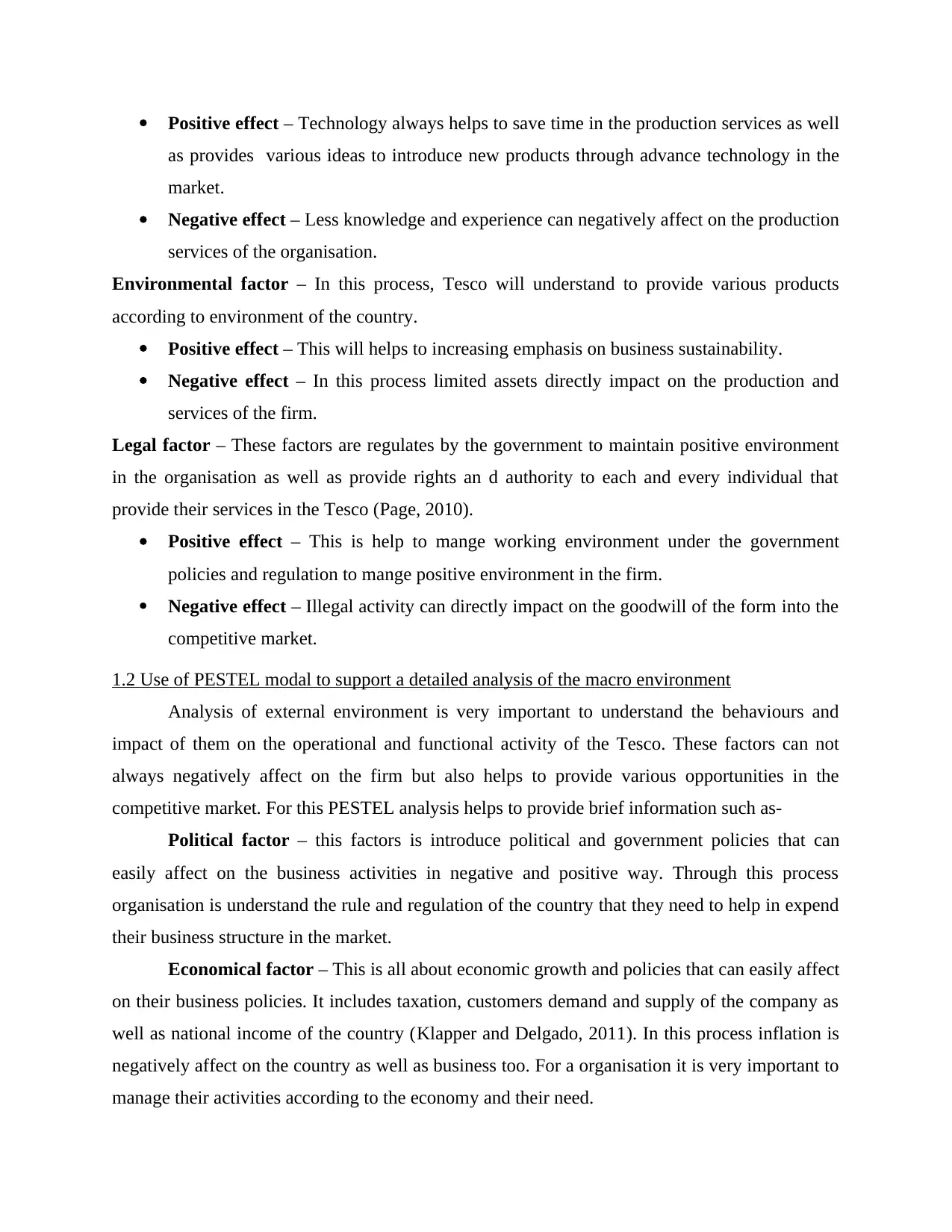
Positive effect – Technology always helps to save time in the production services as well
as provides various ideas to introduce new products through advance technology in the
market.
Negative effect – Less knowledge and experience can negatively affect on the production
services of the organisation.
Environmental factor – In this process, Tesco will understand to provide various products
according to environment of the country.
Positive effect – This will helps to increasing emphasis on business sustainability.
Negative effect – In this process limited assets directly impact on the production and
services of the firm.
Legal factor – These factors are regulates by the government to maintain positive environment
in the organisation as well as provide rights an d authority to each and every individual that
provide their services in the Tesco (Page, 2010).
Positive effect – This is help to mange working environment under the government
policies and regulation to mange positive environment in the firm.
Negative effect – Illegal activity can directly impact on the goodwill of the form into the
competitive market.
1.2 Use of PESTEL modal to support a detailed analysis of the macro environment
Analysis of external environment is very important to understand the behaviours and
impact of them on the operational and functional activity of the Tesco. These factors can not
always negatively affect on the firm but also helps to provide various opportunities in the
competitive market. For this PESTEL analysis helps to provide brief information such as-
Political factor – this factors is introduce political and government policies that can
easily affect on the business activities in negative and positive way. Through this process
organisation is understand the rule and regulation of the country that they need to help in expend
their business structure in the market.
Economical factor – This is all about economic growth and policies that can easily affect
on their business policies. It includes taxation, customers demand and supply of the company as
well as national income of the country (Klapper and Delgado, 2011). In this process inflation is
negatively affect on the country as well as business too. For a organisation it is very important to
manage their activities according to the economy and their need.
as provides various ideas to introduce new products through advance technology in the
market.
Negative effect – Less knowledge and experience can negatively affect on the production
services of the organisation.
Environmental factor – In this process, Tesco will understand to provide various products
according to environment of the country.
Positive effect – This will helps to increasing emphasis on business sustainability.
Negative effect – In this process limited assets directly impact on the production and
services of the firm.
Legal factor – These factors are regulates by the government to maintain positive environment
in the organisation as well as provide rights an d authority to each and every individual that
provide their services in the Tesco (Page, 2010).
Positive effect – This is help to mange working environment under the government
policies and regulation to mange positive environment in the firm.
Negative effect – Illegal activity can directly impact on the goodwill of the form into the
competitive market.
1.2 Use of PESTEL modal to support a detailed analysis of the macro environment
Analysis of external environment is very important to understand the behaviours and
impact of them on the operational and functional activity of the Tesco. These factors can not
always negatively affect on the firm but also helps to provide various opportunities in the
competitive market. For this PESTEL analysis helps to provide brief information such as-
Political factor – this factors is introduce political and government policies that can
easily affect on the business activities in negative and positive way. Through this process
organisation is understand the rule and regulation of the country that they need to help in expend
their business structure in the market.
Economical factor – This is all about economic growth and policies that can easily affect
on their business policies. It includes taxation, customers demand and supply of the company as
well as national income of the country (Klapper and Delgado, 2011). In this process inflation is
negatively affect on the country as well as business too. For a organisation it is very important to
manage their activities according to the economy and their need.
⊘ This is a preview!⊘
Do you want full access?
Subscribe today to unlock all pages.

Trusted by 1+ million students worldwide
1 out of 18
Related Documents
Your All-in-One AI-Powered Toolkit for Academic Success.
+13062052269
info@desklib.com
Available 24*7 on WhatsApp / Email
![[object Object]](/_next/static/media/star-bottom.7253800d.svg)
Unlock your academic potential
Copyright © 2020–2025 A2Z Services. All Rights Reserved. Developed and managed by ZUCOL.




